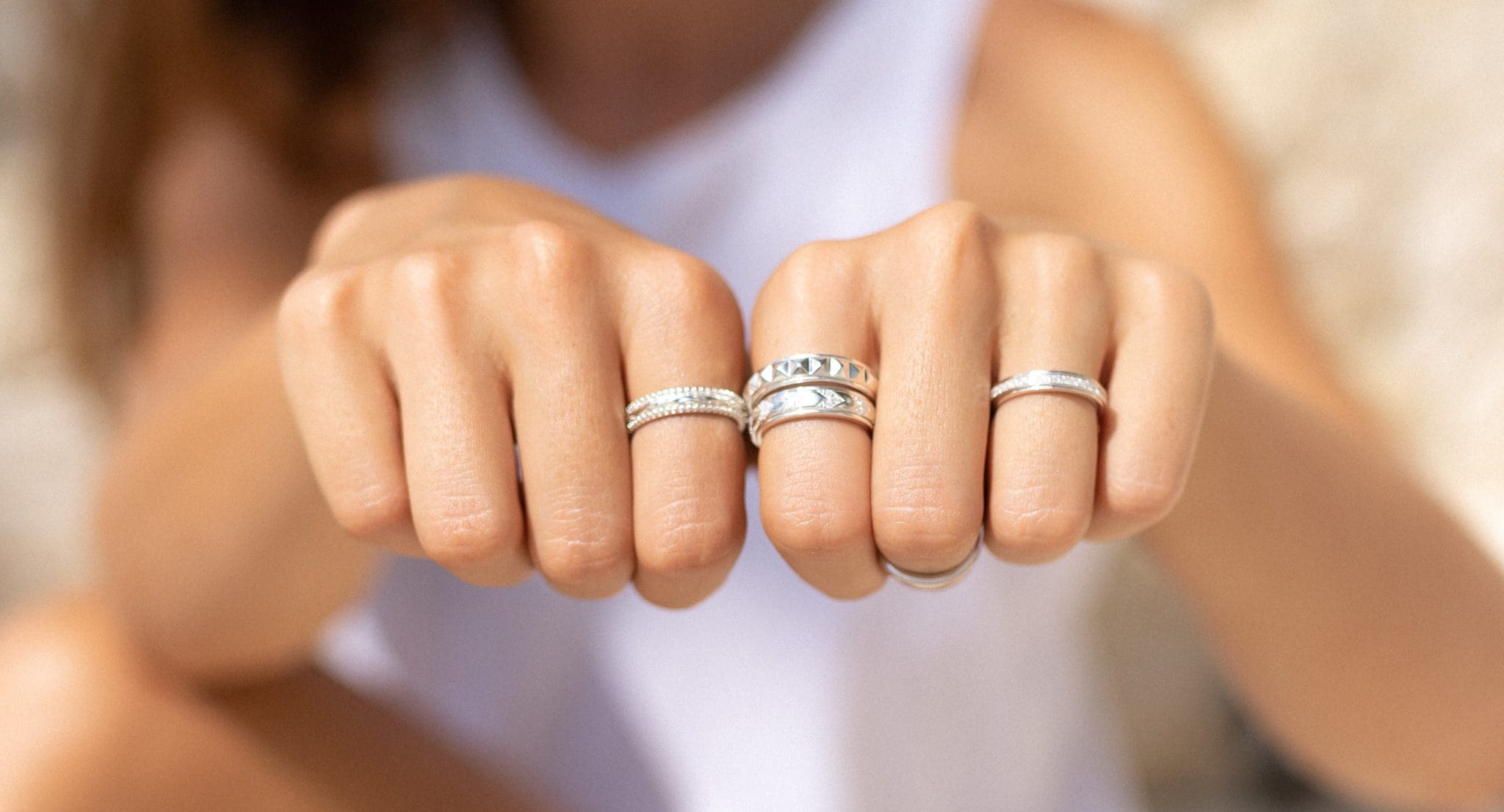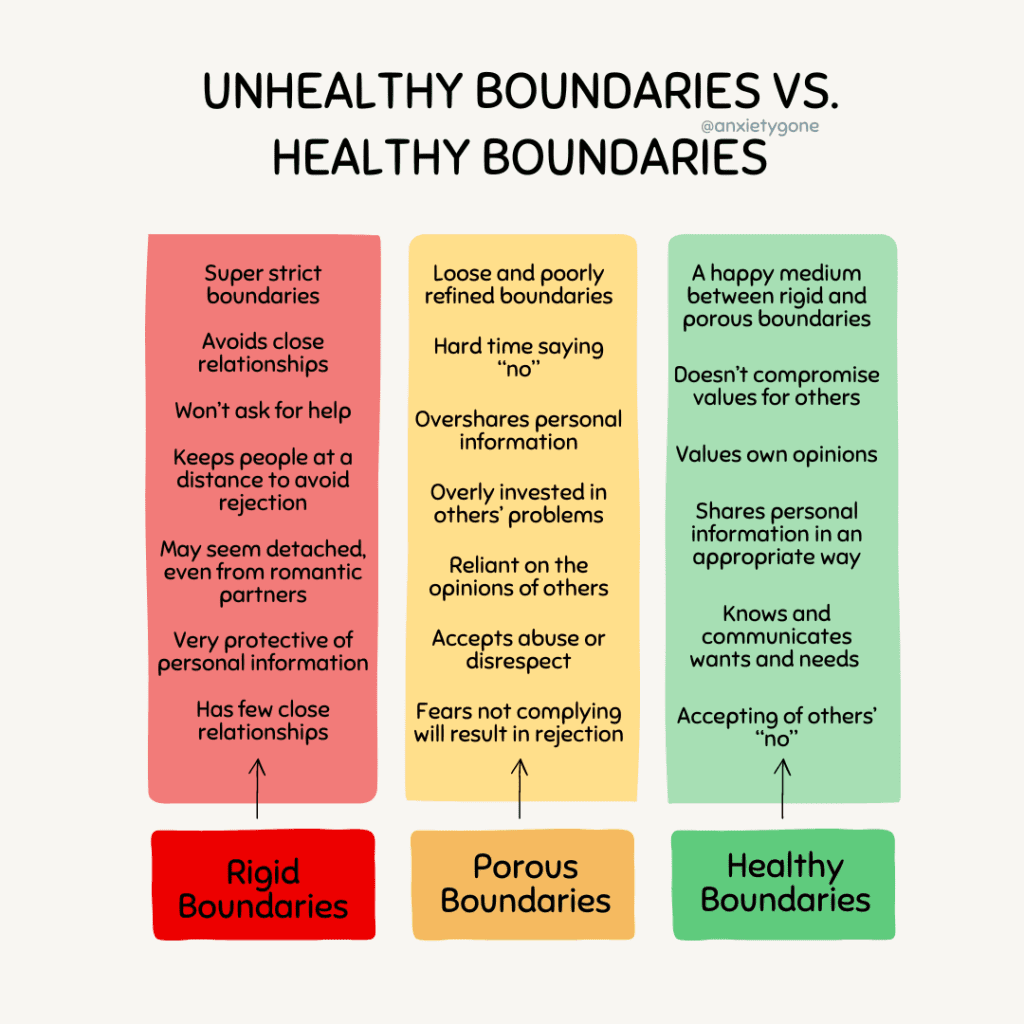Full Disclosure: Clicking on these links could mean a tiny commission for me, at no extra cost to you.
Setting healthy boundaries is not just an act of self-care but an essential step for protecting your mental health and nurturing positive connections with those around you. These invisible lines play a significant role in defining what is acceptable behavior within your relationships. From business meetings to late-night gatherings with friends, boundaries define the expectations we have for ourselves and how others treat up. In this article, we go over the different types of boundaries and steps for setting healthy boundaries in all aspects of your life.

What are Personal Boundaries?
Personal boundaries are the invisible yet crucial limits that define the parameters of acceptable behavior and interaction in various aspects of life. Think of them as the comfort zones we set for ourselves in the wild world of social interactions. They act as personal guidelines the define the space between yourself and others. They are your definition of what you’re comfortable with or find acceptable behaviour. These limits come in different forms, including physical, emotional, and mental boundaries.
These boundaries may have to do with:
- physical contact (not feeling comfortable being hugged)
- verbal interactions (not wanting to be spoken down to)
- your own personal space (choosing to not have others in your home)
Boundaries can also exist in a variety of situations, including:
- at work
- at home
- when visiting family
- when out with friends
- interacting with strangers
The Interpersonal Effectiveness concept of DBT can be a valuable resource for those who struggle with setting boundaries. This aspect of DBT focuses on enhancing skills to ask for what one needs, say no, and cope with interpersonal conflict, which are crucial for establishing and maintaining healthy boundaries.
7 Types of Boundaries to Have
There are many different types of personal boundaries you’ll want to have in place to protect your mental health, peace and relationships. The most common boundaries are:
- emotional (protecting your own emotional well-being)
- physical (protecting your physical space)
- sexual (protecting your needs and sexual safety)
- workplace (protecting your ability to do your work without interference or drama)
- material (protecting your personal belongings)
- time (protecting the use, and misuse, of your time)
There are also many other types of boundaries that you may want to explore, such as intellectual boundaries. However, below is a list of the top 7 personal boundaries to have, along with examples of boundaries for each and boundary violations.
1. Emotional Boundaries
Emotional or mental boundaries ensure your right to your own feelings and thoughts. These boundaries establish a zone where your feelings aren’t up for criticism or invalidation, and you’re not burdened with the task of managing other people’s emotions. They draw a clear line between your feelings and those of others, holding you accountable for your own emotional health without making you responsible for how others feel.
Healthy emotional boundaries play a crucial role in ensuring emotional safety and mental health. They encourage a mutual respect for each other’s feelings and preventing the oversharing of personal information that you feel is inappropriate.
An example of a healthy emotional boundary is:
- If your partner has a hard day at work and comes home in a horrible mood, you don’t have to also be in a bad mood. You can allow them to feel and express their emotions without taking those emotions on as well.
Emotional boundary violations occur in various forms and can deeply impact personal well-being and relationships. These violations include dismissing or criticizing someone’s feelings, asking questions that are too personal for the level of the relationship, or snooping through someone’s emotional information without consent. Other violations involve demanding explanations for someone’s feelings, presuming to understand how another person feels, or dictating emotions to others. Additionally, emotional dumping—where one person offloads their emotional baggage onto another without permission—or sharing inappropriately heavy emotional content with children, can also constitute breaches of emotional boundaries. These actions can lead to discomfort, strained relationships, and emotional distress.
2. Physical Boundaries
Let’s talk about physical boundaries – the unsung heroes that protect your personal space and body. These personal boundaries are all about your right to control who touches you, ensuring privacy, and meeting your physical needs. They communicate to others the distance you’re comfortable with, the kind of touch that’s acceptable (if any), how much privacy you crave, and the behavior expected in your personal space.
Essentially, a physical boundary boldly declares that your body and personal space are your own. Take, for instance, when someone invades your personal bubble by sitting too close; you gracefully move away or express the need for a bit more space.
Therefore, an example of a physical boundary would be:
- Telling a coworker that you prefer not to be hugged or touched can be a way of setting a physical boundary.
Physical boundary violations can range from mild to severe and may include receiving unwanted or inappropriate touch, having your basic physical needs disregarded (such as being told to continue walking when exhausted, or to delay eating or drinking), or experiencing invasions of your personal space (such as someone entering your room without permission). The spectrum of these violations extends to more severe forms, which can result in significant physical abuse or neglect.
3. Sexual Boundaries
Sexual boundaries are all about your right to consent, express your sexual preferences, and be informed about your partner’s sexual history. These healthy relationship boundaries set the stage for the type of sexual touch and intimacy you desire, outlining the specifics of how, when, where, and with whom these experiences take place.
An example of a sexual boundary:
- having a strict no-sex-on-the-first-date policy.
Sexual boundary violations include a range of inappropriate behaviors that can deeply harm and disrespect someone. These include reacting negatively—such as sulking, punishing, or expressing anger—when someone declines to engage in sexual activity. Other violations involve failing to seek consent, pressuring someone into unwanted sexual acts, and making unwelcome sexual comments. Additional inappropriate behaviors include leering, deceiving about contraceptive use or one’s health history, criticizing another person’s sexual preferences, and engaging in unwanted touching, assault, or rape. Each of these actions disregards the personal autonomy and safety of others, leading to significant emotional and physical harm.
4. Time Boundaries
Time boundaries ensure that your time and how you spend it are respected. These boundaries shield you from committing to tasks you’d rather not undertake, prevent others from squandering your time, and ensure you maintain a healthy balance to avoid overwork.
An example of a time boundary:
- Reserving your evenings for time with family members and replying to work emails the following morning.
Time boundary violations can take various forms that disrupt both professional and personal interactions. Examples include requesting a professional’s time without offering payment, excessively demanding someone’s time, or engaging individuals in conversations or tasks beyond the agreed duration. Further infringements occur when someone habitually arrives late or cancels commitments due to overcommitment, or when they contact others during times they have explicitly stated they would be unavailable. These behaviors can lead to feelings of disrespect and frustration, undermining trust and efficiency in relationships.
5. Spiritual Boundaries
Spiritual boundaries pertain to your freedom to believe in what resonates with you, your right to worship according to your preferences, and practice your spiritual or religious convictions.
An example of a spiritual boundary:
- Taking a moment to say a silent prayer prior to eating, and not letting others tell you otherwise.
Spiritual boundary violations involve disrespecting or infringing upon someone’s personal beliefs, practices, or spiritual space. These violations can include forcing religious views on someone, disparaging or mocking their spiritual beliefs, or excluding them from opportunities based on their religious stance. They can also occur when someone’s personal or communal religious practices, like prayer or meditation, are interrupted or disrespected. Other examples include giving unsolicited spiritual advice, pressuring someone to participate in religious activities, or using spirituality to manipulate decisions. Such actions can deeply affect an individual’s spiritual identity and personal peace, making it essential to respect these boundaries for healthy, respectful relationships.
6. Financial Boundaries
Financial and material boundaries are all about protecting your financial resources and possessions. These boundaries define your right to spend your money as you see fit and decide whether or not to lend or give your money or belongings. Financial boundaries can also pertain to work, ensuring that your employer compensates you as agreed upon.
An example of a financial boundary:
- Being on a budget and not allowing others to “bully” you into dining out.
Financial boundary violations occur when someone oversteps another person’s comfort or limits regarding money and resources. This might happen through repeated requests for loans or financial assistance without respecting a previous refusal. It also includes pressuring someone to take on financial responsibilities that are not theirs, such as paying for expenses beyond their agreed share. Other forms of violation include snooping into someone’s financial statements without permission, or giving unsolicited advice about personal spending or investments. These actions can lead to financial strain and resentment, emphasizing the importance of respecting financial boundaries to maintain trust and autonomy in relationships.
7. Workplace Boundaries
A workplace boundary refers to setting limits and guidelines in a professional environment to define acceptable behavior, interactions, and expectations. These boundaries are established to maintain a healthy and respectful workplace atmosphere, ensuring that all individuals feel comfortable, safe, and able to perform their job duties effectively.
Work boundaries can encompass various aspects, including communication style, personal space, work hours, task delegation, and overall professional conduct. Setting clear boundaries for your workplace is crucial for ensuring a positive work environment, promoting effective collaboration, and preventing potential conflicts or misunderstandings.
An example of a workplace boundary is:
- Letting your team and manager know that you do not respond to emails or take calls after 6 PM or on weekends, unless it’s an emergency.












































